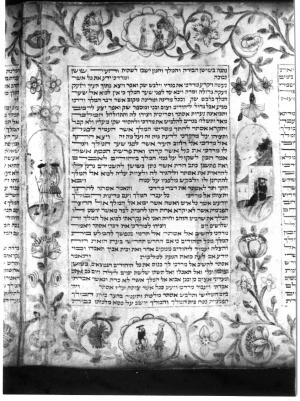Obj. ID: 11814
Hebrew Illuminated Manuscripts Esther Scroll with Illustrations and Floral Motifs, Germany or Alsace, mid-18th century

The Hebrew text of the Book of Esther starts with a framed, enlarged word ויהי shown against a decorative background and is inscribed within rectangular panels. The upper and lower margins along the whole length of the manuscript and the spaces between the text panels are embellished with tendrils and flowers. In them, the ovals with the episodes from the Book of Esther narrative supplemented with midrashic tales are woven. The illustrations include scenes that only rarely were incorporated into the narrative cycles of the megillot such as the representation of the naked Queen Vashti with horns (it refers to the midrashic tale that explains why the queen refused to stand in front of King Ahasuerus and his guests) and Mordecai accompanied by three boys (it alludes to the midrashic story telling about Mordecai who was teaching the Scriptures when Haman arrived to take him on a parade through the streets of Susa). In a few ovals, landscapes are depicted. The scroll contains one further illustration depicting the scene of hanging of Haman’s ten sons (Es. 9:14) that is incorporated directly into the ninth text column.
The scroll is stored in a leather case with a silver element in the mid of its height. Possibly silver hallmark 800 and three other hallmarks are visible on it. There are also initials “H.Z.L.” on it and on the top part of the lid, there was a Hebrew inscription that at present is barely visible.
This megillah belongs to a group of scrolls sharing similar ornamentation possibly executed by the same artistic milieu(s). For similar scrolls in the Index see IDs: 37874.
sub-set tree:
The length of the sheets in the scroll: 1) 518 mm, 2) 585 mm, 3) 250 mm.
The scroll is formed of 3 sheets containing 11 columns of text with 31 or 32 lines, except for col. 9 with 11 lines divided into two parts.
The number of columns per sheet: no. 1 - , nos. 2 and 3 - .
The text is inscribed in the Hebrew square Ashkenazi script, in black ink, on the flesh side of parchment membranes.
The letter ח (Es. 1:6) is formed of two parts joined with a roof and decorated with scrolled feet. The letter ת (Es. 9:29) is enlarged and bolded. Other enlarged and diminished letters are included in col. 9.
The ruling and pricking are invisible.
The membranes are glued that in the scrolls was a less frequently used method of joining the sheets than stitching.
Unknown












